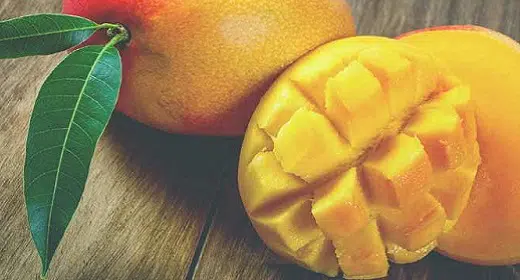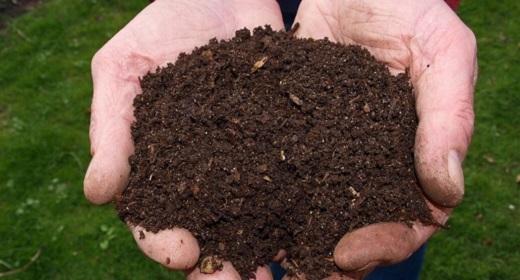by Ocean Robbins: Although it may not be as revered as the apple, banana, or even tomato (at least in the western world), the mango is one of the most commonly eaten fruits worldwide…
And production has gone up around 17% in the last few years globally, averaging over 55 million mangoes per year.
This luscious, juicy, sweet fruit that has won fans the world over originated in India, where it has a long and revered history. One of the central rituals of Hinduism, the puja ceremony, uses water infused with mango leaves to create the proper resonance for honored deities. Indian poets also use mangoes to evoke emotions like lust and love. And contemporary Indian novelists like Arundhati Roy and Anita Desai draw upon mangoes to symbolize abundance, sweetness, and possibility.
The mango is the national fruit of India, which produces more than half of all the mangoes consumed worldwide. Other top growers include Thailand, Mexico, and the tropical regions of China. In the US, mango trees can thrive in Hawaii, Florida, and parts of California.
With billions of fans and centuries of great PR, you’d think that mangoes have it made. But due to their high sugar content, mangoes are often vilified by low-carb enthusiasts. And because they’re exported around the globe, some environmentalists express concern over their carbon footprint and sustainability.
So are mangoes good for you, and the planet? Can we enjoy them without worrying about our health or their environmental impact? And, just as controversial, is the plural form of mango spelled “mangos” or “mangoes”?
Types of Mangoes
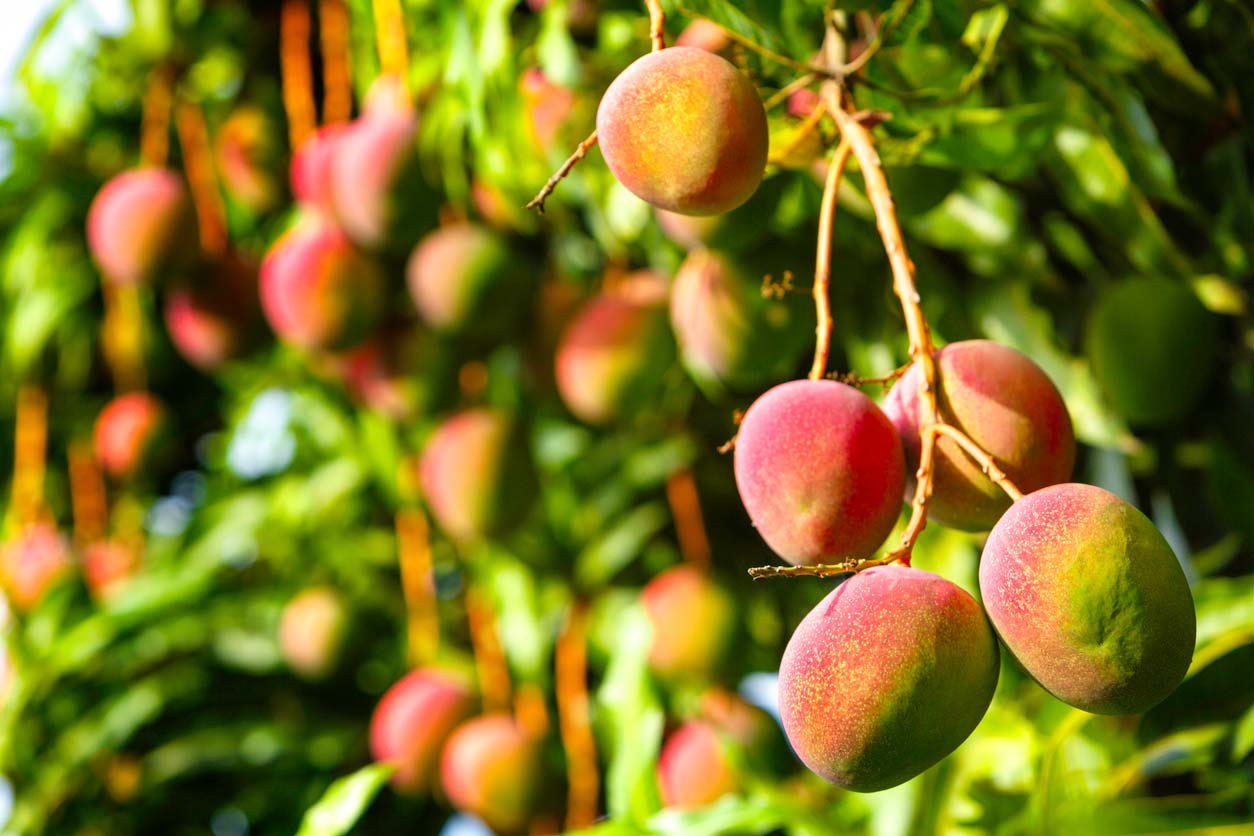
Mangoes are a stone fruit, like peaches, plums, and cherries. The official biological name for such a fruit is a drupe, which might come in handy in a tight game of Scrabble. The mango tree, whose botanical name is Mangifera Indica, is part of a pretty intense family, the Anacardiaceae. Other members include cashews and sumac, along with our good friends poison ivy and poison oak. All these plants can cause allergic reactions in humans, thanks to the oily compound urushiol found in their sap.
Mangoes come in a variety of types and colors, and their taste varies depending on variety as well as the degree of ripeness. Typically, mangoes are sweet and juicy, with varying degrees of tartness. Some folks describe their flavor as similar to those of peach, pineapple, and apricot, although as someone who’s eaten plenty of all these fruits, there’s no way to compare one to another. Some things just don’t translate into words, and the taste of a ripe mango is one of them.
While there are over 1,000 varieties of mango growing worldwide (including the evocatively named “huevos de toro,” which should not prove too esoteric to anyone who’s taken high school Spanish), we see six main types in US grocery stores. And given the mango’s storied pedigree, the names are pretty bland: Honey (also known as Ataulfo), Francis, Haden, Keitt, Kent, and the dominant variety in the UK and US, Tommy Atkins, which sounds more like a boy band member than the world’s best-selling mango, but what do I know?
Other varieties that pop up from time to time include Alphonse, Edward, Kesar, Manila, and Palmer (which, I’m sorry to report, was not named after the legendary golfer, Arnold Palmer).
Mango Nutrition

Like most whole plant foods, mangoes are nutrient-dense. They’re high in many vitamins, especially A, C, and B6. And they contain a small amount of protein, as well as some copper and potassium. Their heightened sweetness indicates that mangoes are high in calories and carbohydrates (which is why our ancestors’ preference for sweets, which most of us have inherited, was such an important survival mechanism).
With all those natural sugars, you might think they’re a no-no for people with diabetes, or anyone wanting to avoid spiking their blood sugar. But raw mango ends up mid-range on the glycemic index (51 out of 100) because of its high fiber content. In fact, one cup of raw mango provides three grams of fiber, which fulfills 12% of the US recommended daily intake.
Benefits of Mangoes
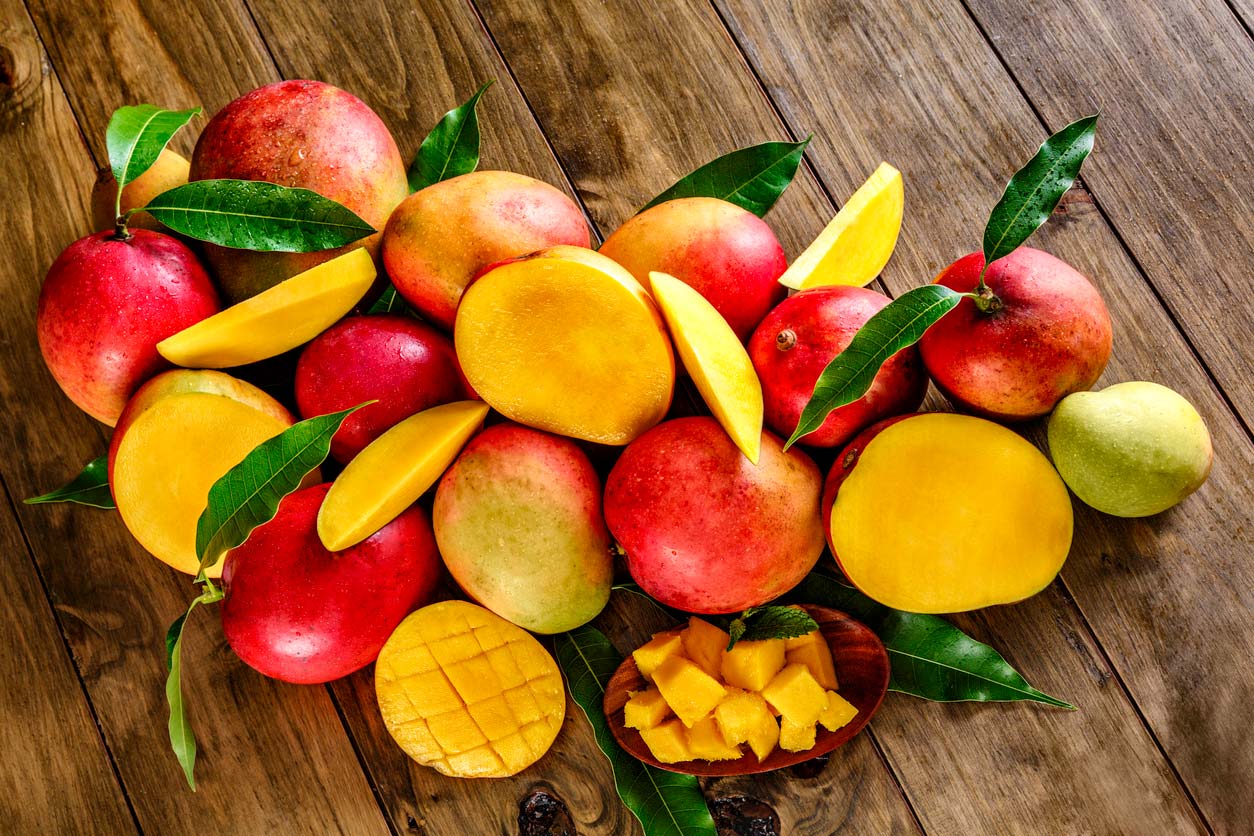
So are mangoes good for you, then? Researchers are discovering more and more health benefits of mangoes all the time. Both in laboratory assays and in clinical trials, mangoes are dazzling scientists with the breadth of their positive impacts.
Anti-inflammatory
For one thing, mangoes appear to be highly anti-inflammatory. In a study that I find ethically disturbing, mice who were given ulcerative colitis experienced an improvement in symptoms when given extracts of the mango fruit itself, as well as a compound found in the tree’s stem bark.
Other studies found that enzymes in the fruit were protective against ulcers in both mice and rats. Given how many humans already suffer from these conditions, and that rodent trials don’t always correlate to human results, it sure would be nice if we conducted clinical trials with people eating actual mangoes. We’d reduce animal suffering and possibly human suffering as well.
High in Antioxidants
Mangoes contain high concentrations of both ascorbic acid (vitamin C) and various polyphenols, which are phytonutrients — nutrients found in plants — that have a host of positive effects. One such polyphenol specific to mangoes is mangiferin, which helps reduce iron overload (again, in rats and mice), and could be a useful addition to the diets of people with hemochromatosis (a condition that often produces excessive iron in the blood).
Other antioxidant compounds found in mangoes may prevent oxidative stress (think of rusting, except inside your body rather than that old bike frame you left leaning against the garage for four years), and may actually repair oxidative damage related to aging, cancer, atherosclerosis, heart attack, stroke, and diabetes. No, it won’t work on a bike frame, but the human body is pretty miraculous.
Anticancer Properties
Mangoes may have powerful anticancer effects on tumor cells. Now we move from the world of animal studies to the test tube, where cancer cells and potential anticancer compounds fight it out under the bright glare of science. In these contests, mango extracts keep coming out on top.
A team from Texas found that compounds found in mangoes killed tumor cells in multiple types of cancer, including pancreatic, cervical, colorectal, and breast. Notably, the compounds triggered apoptosis (cell death) in the cancer cells, but not in healthy human cells. One caveat: the studies were all funded by the National Mango Board, which doesn’t negate the results, but suggests that the studies need to be replicated by researchers without any potential conflicts of interest.
Diabetes Treatment & Prevention
Remember how one of the supposed problems with mangoes is their high sugar content? You might expect such a fruit to wreak havoc with the blood glucose of someone suffering from diabetes. But you’d be wrong. It turns out that, in rat studies, at least, mango consumption actually decreases blood glucose levels. This puts the fruit in the same category as a bunch of anti-diabetic drugs. But in the case of the mango, the blood sugar heroes appear to be the polyphenols, carotenoids (another family of phytonutrients found in orange-hued plants), and high fiber content.
Not everyone reacts the same way to particular foods, so you’ll want to see for yourself the effects of mango consumption on your blood sugar if that’s a concern. Start by sticking to a single serving. And if you have a condition that requires blood sugar monitoring, test your blood sugar after eating to see how your body responds. Keep in mind that mango juice may have a different effect than eating whole fruit pieces. When fruits are pulverized and their fiber is removed, the absorption of sugars happens much quicker.
What about dried mango? Any time you try dried fruit, you’re removing most of the water from it, which concentrates both the nutrients and the sugars. As such, unsweetened dried mangoes are an even richer source of fiber and antioxidants — and they can also taste even sweeter. In general, their glycemic load is considered similar to that of fresh mangoes although some researchers say it might be a bit higher.
Some dried mango also comes with added sugar. Why anyone would add sugar to such a sweet fruit is beyond me, but if that’s the case, then as far as I’m concerned, it ceases to be a healthy food and becomes more of a candy.
May Protect Your Skin
It’s poetically fitting to think that a fruit with such smooth skin might help protect your skin, too. That is, the mango might help protect you from UV radiation damage caused by the sun. What we know, thanks to a 2013 study out of an anti-aging laboratory in Korea, is that mango extract reduced and to some extent reversed the effects of UVB radiation on a group of hairless mice.
When it comes to preventing wrinkles, things get more complicated. The good news is, in 2020, we finally got a study on the effects of mangoes on humans, as opposed to rodents. The better news is, the humans consented to participate in the study. And the best news is… Sixteen weeks of daily doses of 85 grams (about ½ cup) of ataulfo mango reduced wrinkle size and severity in a group of postmenopausal women. The bad news is, the effect was dose-dependent, with the group that consumed the largest amount (250 grams, which comes to more than 1 ½ cups of mango per day) experiencing greater wrinkle length and severity. (So there you go, apparently, you can have too much of a good thing.)
It’s unclear what caused the 250-gram group’s worsening wrinkles. The researchers were clearly confused by the unexpected finding and speculated that the high sugar content of the larger amount of mangoes may have caused glycation of collagen fibers (basically, they get sticky and glom together), which made the wrinkles grow. Since both groups were on a roughly 1,700 kcal/day diet, I also start to wonder if the group eating more mangoes compensated for the extra mango calories by cutting back on other foods that are also skin-protective in other ways.
Risks of Eating Mangoes
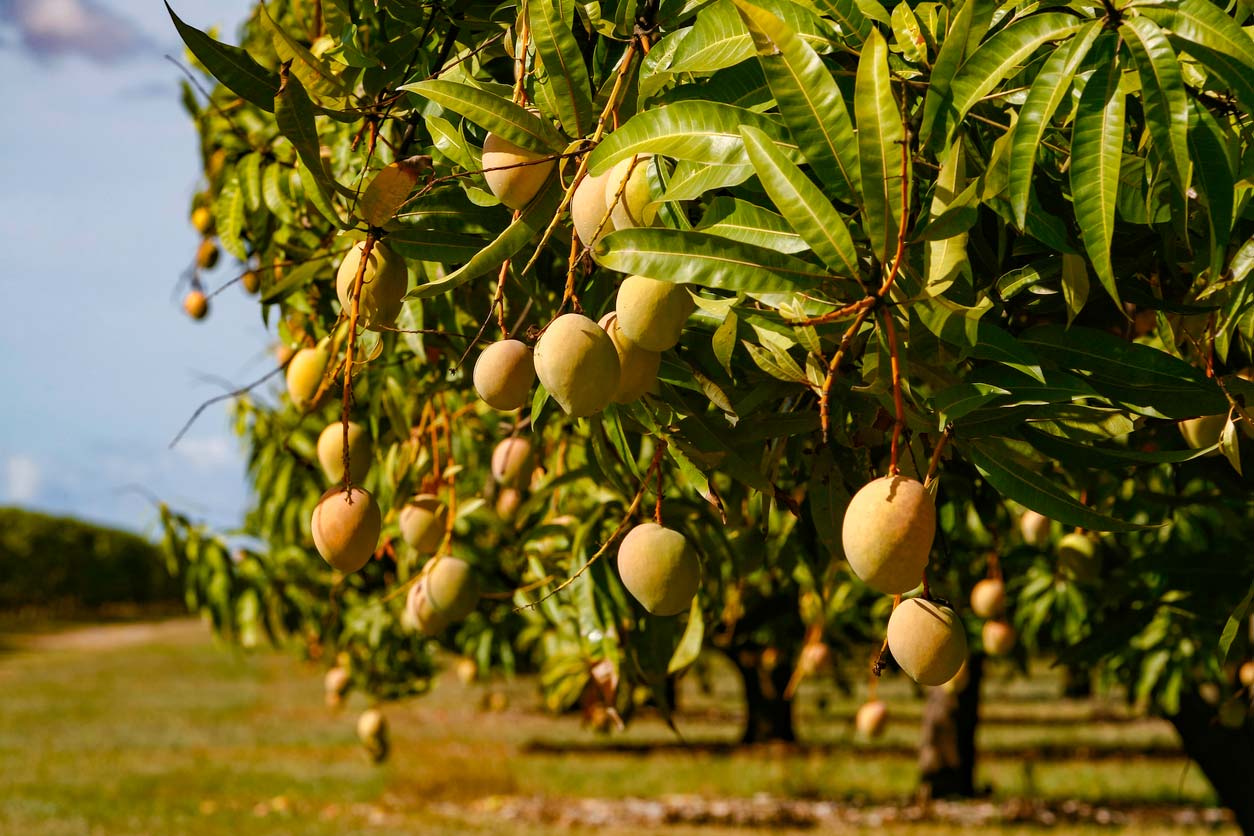
Why, in addition to concerns about wrinkles, might you want to moderate your mango intake, or avoid them entirely? One very convincing reason is if eating a mango gives you a case of an oral allergy syndrome.
This condition is characterized by itching and swelling of the mouth, lips, and throat, accompanied by skin reactions, asthma, and rhinitis (inflammation of the mucous membranes of the nose). If things really get bad, the syndrome can include cardiovascular symptoms and anaphylaxis. In that case, the best course of treatment is usually a shot of epinephrine. So if you or someone you know experiences any of those symptoms following eating or touching a mango, seek medical attention right away.
And remember how mangoes are related to poison ivy and poison oak? Well, they have more in common than just an ancient ancestor. The sap, leaves, and bark of the mango tree, and in some cases the skin of the fruit, can produce the same blistering skin rash in susceptible individuals. If you know you respond badly to poison ivy, you might want to go slow with adding mangoes to your diet, until you know they don’t cause an allergic reaction — and also to handle mango skin with caution.
Pesticides
The Environmental Working Group, which rates produce in terms of pesticide exposure, places mangoes in the middle of the pack (specifically, mangoes are the 31st most pesticide-laden produce of all the ones EWG includes in their ratings). They aren’t featured in either the Dirty Dozen or the Clean 15. Compared to other produce, mangoes are comparatively low in pesticides. On the other hand, researchers from the USDA Pesticide Data Program did detect 11 distinctively different pesticides in mangoes. That’s a good reason to peel mangoes before eating and to choose organic if possible.
Are Mangoes Sustainable?

Unless you live in the tropics, the mangoes available at your local grocery store or market are imported from somewhere else. For consumers in the US, that somewhere else is most commonly Mexico. For those of us who try to eat more local foods to reduce the carbon footprint of our diets associated with the transport of distant foods, that might disqualify mangoes as an everyday fruit.
On the other hand, folks in the US import lots of other foods from Mexico and South America too: tomatoes, grapes, squash, melons, asparagus, and so on. The US National Mango Board commissioned a sustainability assessment in 2017 and determined that the greenhouse gas emissions from mangoes were similar to those from other imported fruits and vegetables from Mexico. Most of these emissions arose from two sources: agrochemicals (including fertilizers) and transport. If you go with organic mangoes, then far fewer agrochemicals will be used, which naturally reduces the environmental impact.
However, unlike the other produce listed above, mangoes come from trees. And Mexico’s mango orchards help compensate for the greenhouse gas emissions generated through the production and distribution of the fruit through carbon sequestration. Researchers in 2019 found the same to be true of Indian mango production: the trees’ ability to trap carbon in their tissue and surrounding soil makes their fruit much more sustainable even when exported far and wide.
Water & Labor Conditions
Where mango trees lose their sustainability edge is in their relatively high water requirements. Mangoes use, on average, 1,000 liters of water for every kilogram of fruit produced. Many other crops use less: oranges require 330 liters/kg, watermelons need 378 liters/kg, and tomatoes only 64 liters/kg.
But there may be a fix for this problem. In India, some mango farmers have adopted what’s known as the ultra-high-density planting method, which can increase the productivity of trees 2-3 times, reduce water requirements by up to 50%, and increase fertilizer intake, which means less watering is necessary (and thus, less CO2 is released).
Another potential concern with mangoes is agricultural labor conditions. Simply put, many tropical fruits and vegetables come from countries that don’t have great labor regulations. And when farmers are paid rock bottom prices in a competitive marketplace, they may not have the means to pay their workers fairly. If you are able to buy organically grown and fair-trade certified mangoes, you help to ensure that farmworkers aren’t exposed to pesticides on the job and that the people who grew your food were paid enough to live with a degree of dignity.
How Do You Know When a Mango Is Ripe?
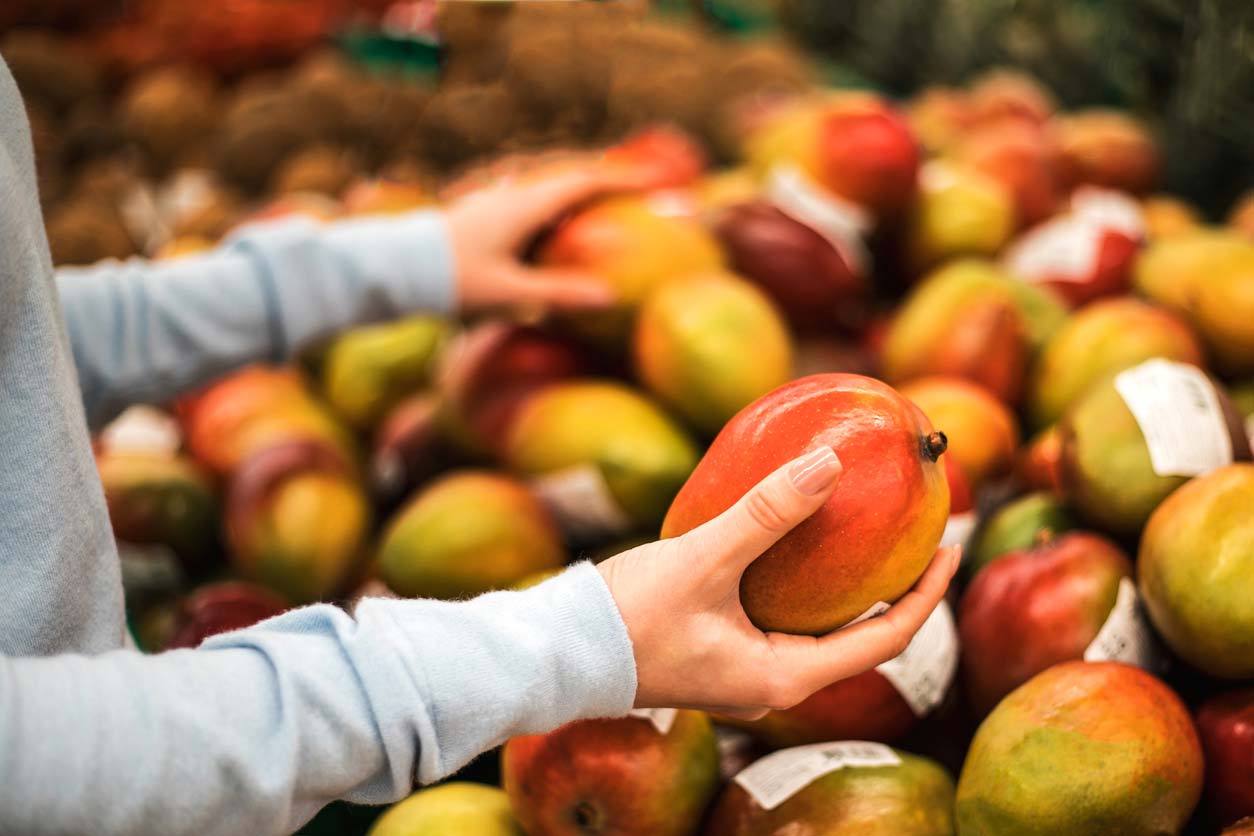
So now it’s time for the rubber to meet the road (or in this case, for the mango to meet the machete). How can you tell if that mango you want to eat is ripe? For answers, I turned to the experts at the National Mango Board and cross-checked their advice with that of the fine folks at the Produce for Better Health Foundation.
Basically, you want to judge ripeness by feeling, not by color. The fruit should feel soft (not mushy) to the touch, like a ripe peach or avocado. Sometimes you can also go by smell; a fruity aroma near the stem says that your mango is ready to be eaten. The inside of a ripe mango will be soft, and the flesh will be yellow or orange.
Avoid fruit with bruises, soft spots, and indentations, as well as skin damage. It’s better to buy a firm, unbruised mango and allow it to ripen than to dig into a mushy mango that may already be overripe. Mangoes typically ripen in a few days at room temperature. To speed that up (like supposing that you have a date coming over and you want to invoke the mango’s erotic nature like all that ancient Indian poetry), you can place mangoes in a paper bag to concentrate the ethylene gas that they naturally release. Once they’re perfectly ripe, you can slow down the process by placing them in the refrigerator until you’re ready to serve them.
How to Prepare & Use Mangoes
You can eat a fresh mango the messy way, with your hands, just make sure you have running water nearby because you’ll likely end up with juice dribbling down your chin. For sharing, or for fruit salads, there are several elegant ways to cut a mango. The folks at the National Mango Board have thoughtfully created a 36-second video that demonstrates the most popular one, complete with an upbeat folk-rock background track that may move you to mute your speakers for the duration.
Alternatively, here’s a longer video on five easy ways to cut a mango by YouTube user Not Another Cooking Show.
You can enjoy mangoes raw or cooked. And you can buy them fresh as whole fruit, and also as frozen chunks, dried, or even pickled (like in Indian mango chutneys). If you buy a fresh mango, make sure to wash it well before peeling. You can slice or scoop it like an avocado. You can also use mango in smoothies, salads, curries, jams or chutneys, salsas and sauces, and n’ice cream (that’s ice cream without the dairy — it’s especially lovely with a frozen banana base) and ice pops.
Mango-licious Recipes
The recipes below show the versatility of mangoes, setting the stage for sweet or savory, whichever you prefer (we suggest trying all of them!). Crispy Curry Tofu Poppers with Sweet Mango Sauce make the perfect party appetizer or meal (with a side of whole grains and veggies). Spring Fruit Salsa combines mango, pineapple, strawberries, and red onion into one dish that elevates everything from tacos to avocado toast. Finally, Mango “Sassy” is a take on India’s popular beverage, Mango Lassi, but with plant-based milk in place of yogurt. Enjoy it as a drink or have fun creating popsicles out of this naturally sweet blend!
1. Crispy Curry Tofu Poppers with Sweet Mango Sauce
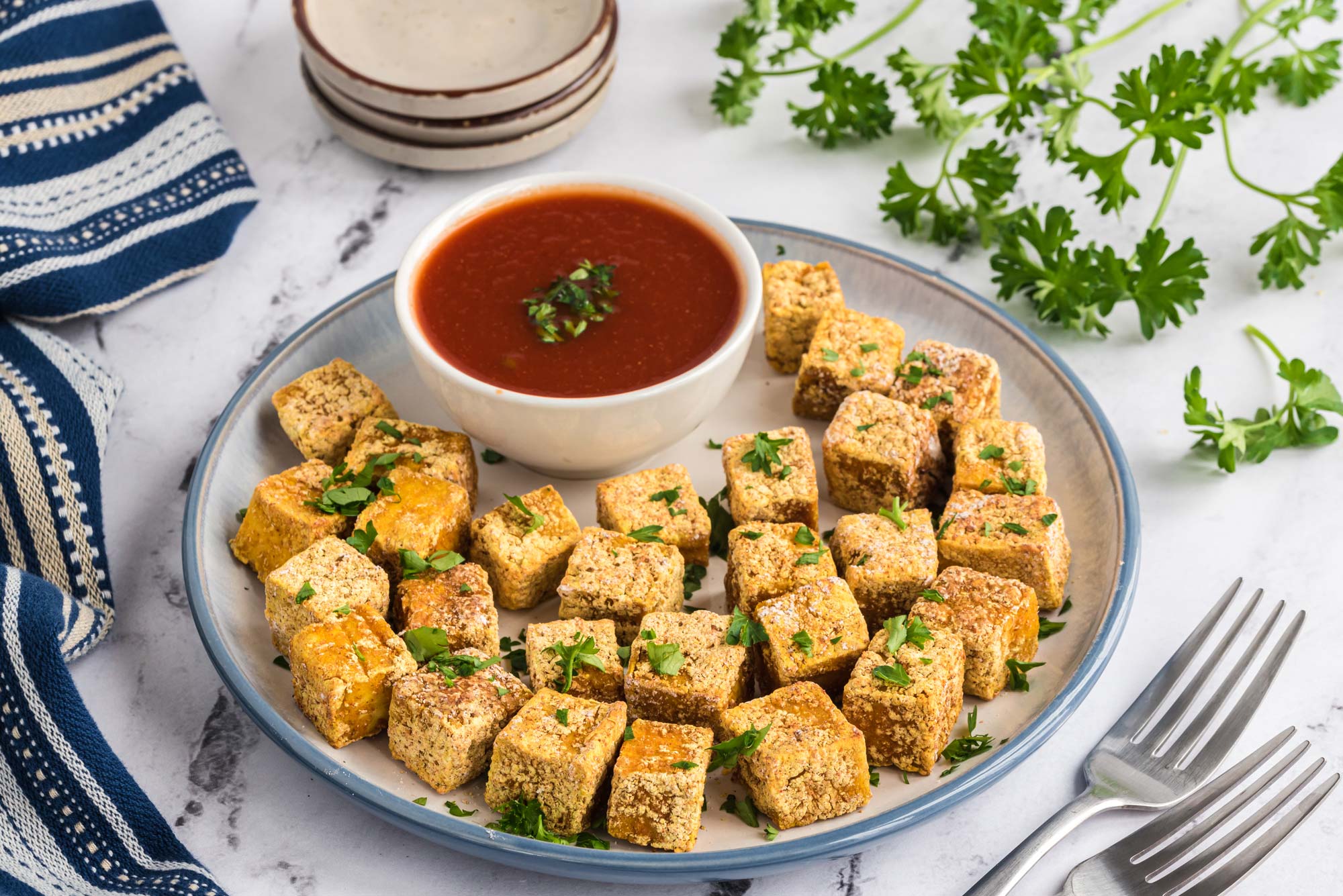
If you’re new to tofu (or even a “seasoned” tofu enthusiast), enjoying it with this sweet and tangy mango sauce is a great way to start (or continue) your tofu journey! With their natural sweetness, mangoes complement tomato paste perfectly to make a sauce that’s also delicious with mushroom tacos, steamed veggies, and grain bowls.
2. Spring Fruit Salsa
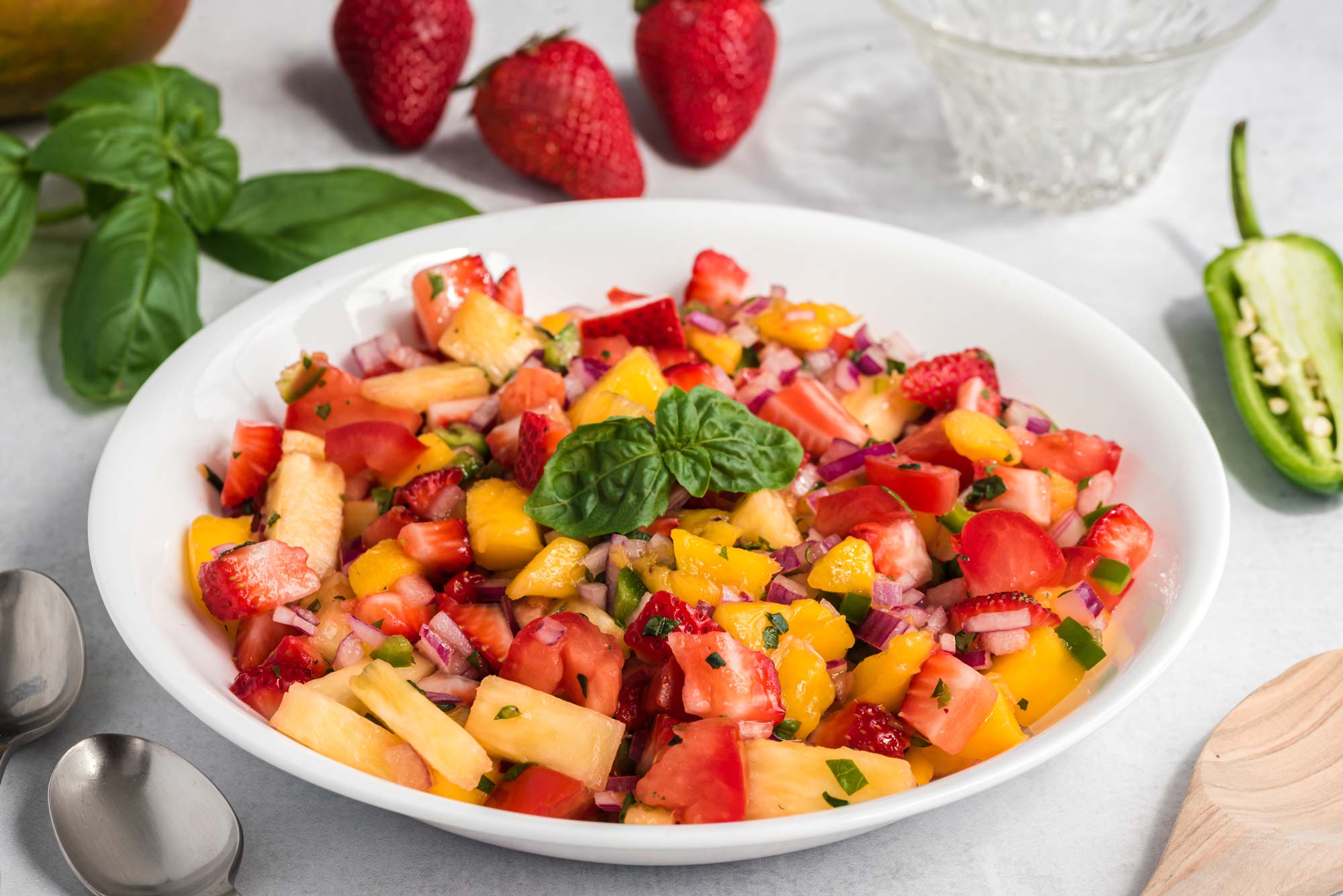
The sweetness of mango, pineapple, and strawberries balances the pungency of the onion and the tartness of the lime juice so well that you might find yourself adding this to everything from your tacos to your salads to eating it straight out of the bowl! Pro tip: Let the salsa sit overnight after you make it for the most delectable flavors that will brighten your meals.
3. Mango “Sassy”
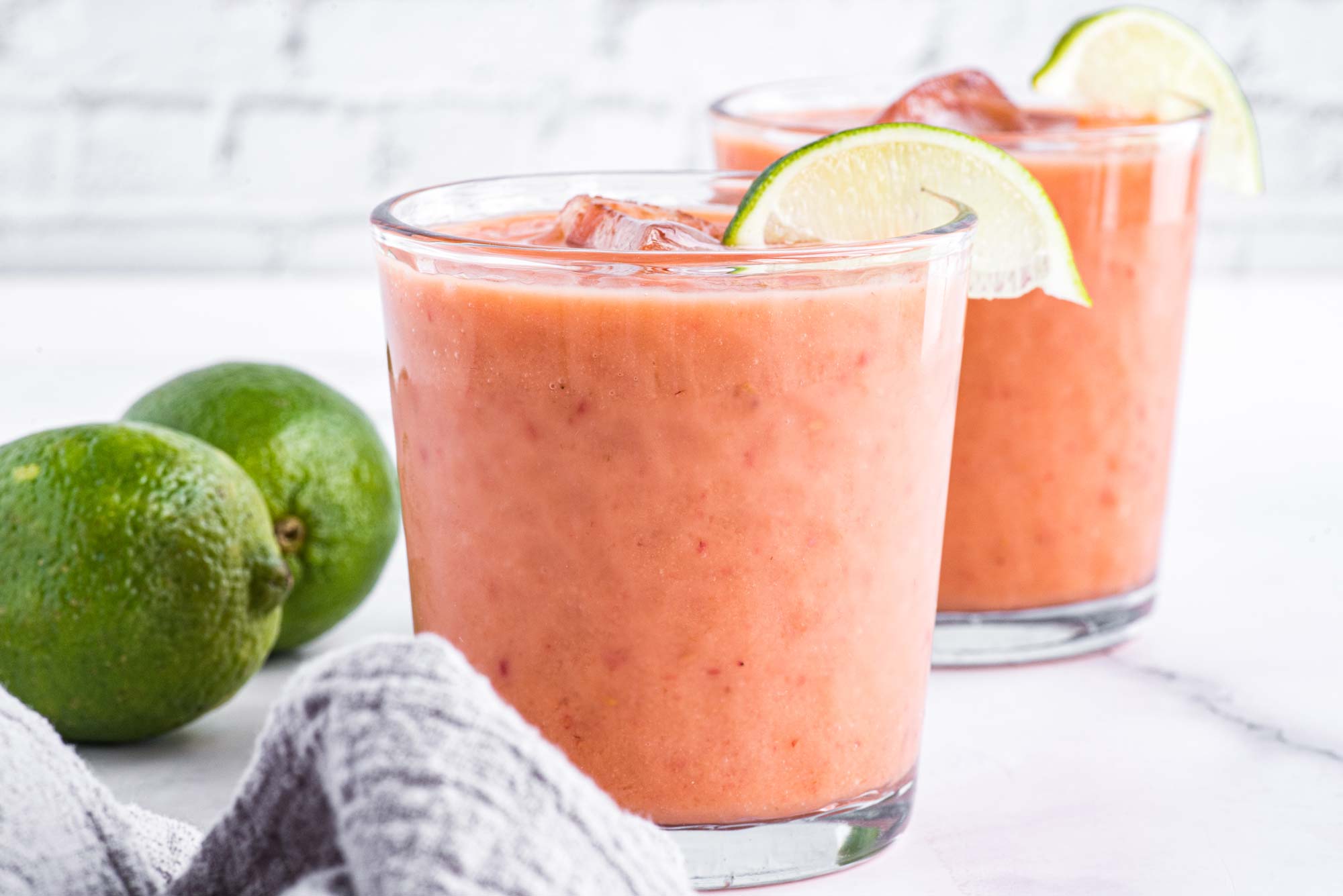
‘Tis the season for cool and refreshing drinks that also contribute to health and wellness. Introducing the Mango “Sassy!” This summer treat contains nutrients to keep your skin protected while in the sun (but, still wear your sunscreen) and your immune system strong to fight off summer colds. Fun tip: Create popsicles with the leftovers!
Enjoy Mangoes
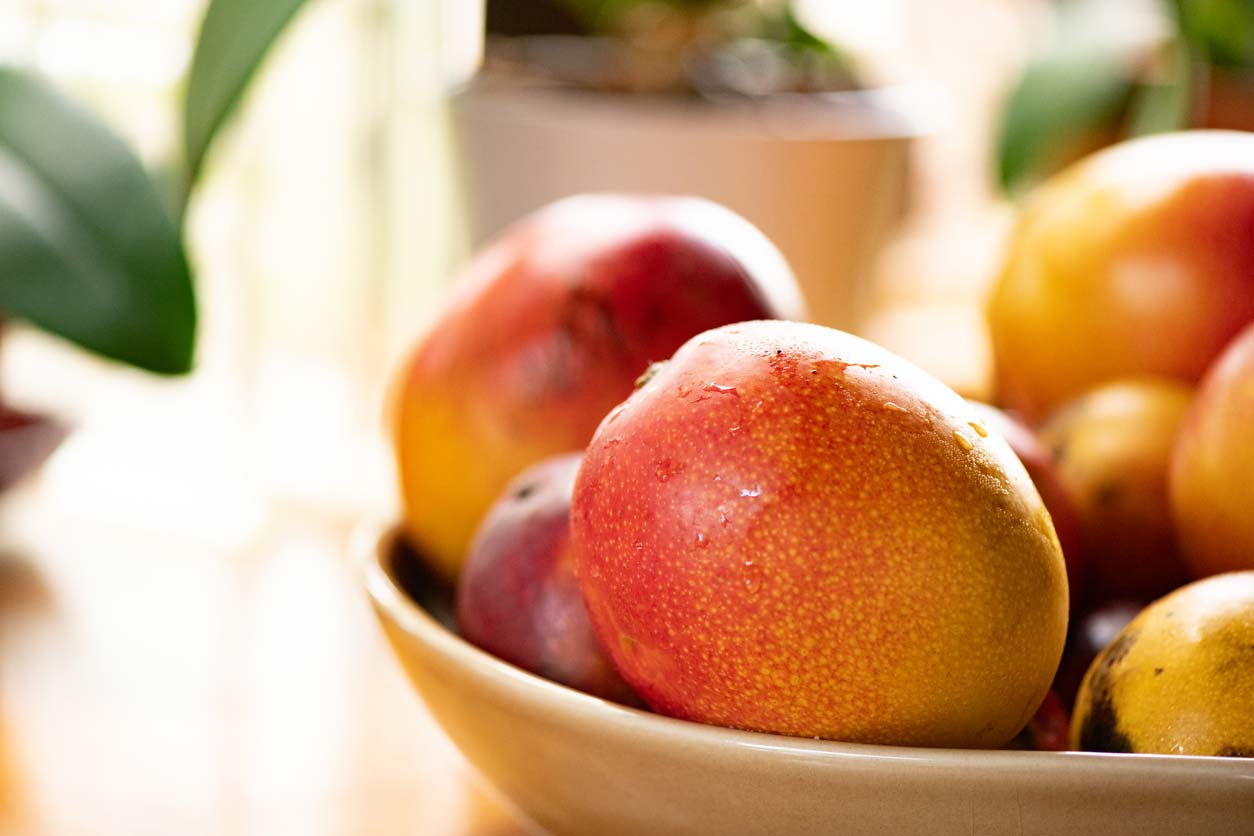
Mangoes are well-loved fruit, and they’re a rich source of fiber and antioxidants. Although they’re high in sugar, in their whole food form, they can still be an excellent part of a well-balanced diet and are, in fact, good for you! You can use and prepare mangoes in many fun and nutritious ways. Although there are some health risks and environmental considerations regarding mangoes, the benefits mostly outweigh the risks. And if possible, go for fair-trade and organic mangoes to reduce possible negative impacts on farmworkers and the environment.
Oh, and about that “mangoes” vs “mangos” question: the answer is — the experts have no consensus, so you get to choose whichever option you like. Some words that end in “o” get an “e” added to the plural (heroes, potatoes), and some don’t (photos, egos). If you’re writing a term paper about the fruit, and you want to fill more pages, add the “e.” If you’re trying to compose a mango-centric Tweet and nearing your character limit, leave it out. It’s totally your call.
Source: Food Revolution







